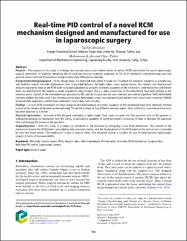| dc.contributor.author | Aksungur, Serhat | |
| dc.contributor.author | Aydın, Muhammet | |
| dc.contributor.author | Yakut, Oǧuz | |
| dc.date.accessioned | 2021-06-15T18:02:07Z | |
| dc.date.available | 2021-06-15T18:02:07Z | |
| dc.date.issued | 2020 | en_US |
| dc.identifier.citation | Aksungur, S., Aydın, M., & Yakut, O. (2019). Real-time PID control of a novel RCM mechanism designed and manufactured for use in laparoscopic surgery. Industrial Robot: the International Journal of Robotics Research and Application, 47, 2, 153-166. | en_US |
| dc.identifier.issn | 0143-991X | en_US |
| dc.identifier.issn | 1758-5791 | en_US |
| dc.identifier.uri | https://doi.org/10.1108/IR-09-2019-0179 | |
| dc.identifier.uri | https://hdl.handle.net/20.500.12899/258 | |
| dc.description.abstract | Purpose: The purpose of this study is to design and manufacture a new remote center of motion (RCM) mechanism for use in laparoscopic surgical operations. In addition, obtaining the forward and inverse kinematic equations of the RCM mechanism and performing real-time position control with the Proportional–Integral–Derivative (PID) control method. Design/methodology/approach: At the design stage, it is benefited from similar triangle rule. To obtain the kinematic equations in a simple way and facilitate control, two-fold displacement ratio is provided between the limbs where linear motion occurs. The rotation and displacement amounts required to move at the RCM point have been calculated by using the kinematic equations of the mechanism. Limb dimensions and motion limits are determined in the manner to avoid singularities and collisions. The x, y and z coordinates of the end effector have been defined as the reference point. Control of the mechanism was provided by PID control. To generate the user interface and control algorithm, MATLAB/Simulink real-time toolbox has been used. Four reference points were determined, control was performed and position error values were examined. MF634 Humusoft data acquisition card has been preferred to collect data from encoders. Findings: A novel RCM mechanism has been designed and manufactured. Kinematic equations of this mechanism have been obtained. Position control of the cannula tip has been performed using PID control method for four different reference points. After settlement, maximum position error has been observed as 0.45 mm. Practical implications: Structure of the designed mechanism is quite simple. Thus, costs are quite low. The operation area of the operator is widened by hanging the mechanism from the ceiling, so operational capability of health personnel is increasing. It helps to decrease the operation time and increase the success of the operation. Originality/value: With this study, it is aimed to contribute to the literature by designing a new RCM mechanism. The rotation of the mechanism around the RCM point is provided by only one rotary motor, and the displacement of the RCM point in the vertical axis is provided by only one linear motor. The mechanism is also a surgical robot. The designed system is suitable for use in robot-assisted laparoscopic surgery in terms of maneuverability. | en_US |
| dc.language.iso | en | en_US |
| dc.publisher | Emerald | en_US |
| dc.relation.ispartof | Industrial Robot | en_US |
| dc.rights | info:eu-repo/semantics/closedAccess | en_US |
| dc.subject | Minimally invasive surgery (MIS) | en_US |
| dc.subject | Surgical robot | en_US |
| dc.subject | Hybrid mechanism | en_US |
| dc.subject | Remote center of motion (RCM) mechanism | en_US |
| dc.subject | Surgical robot | en_US |
| dc.subject | Real-time PID control | en_US |
| dc.subject | Laparoscopic surgery | en_US |
| dc.title | Real-time PID control of a novel RCM mechanism designed and manufactured for use in laparoscopic surgery | en_US |
| dc.type | Article | en_US |
| dc.authorid | 0000-0001-9707-3799 | en_US |
| dc.department | MTÖ Üniversitesi, Arapgir Meslek Yüksekokulu, Motorlu Araçlar ve Ulaştırma Teknolojileri Bölümü | en_US |
| dc.institutionauthor | Aksungur, Serhat | |
| dc.identifier.doi | 10.1108/IR-09-2019-0179 | |
| dc.identifier.volume | 47 | en_US |
| dc.identifier.issue | 2 | en_US |
| dc.identifier.startpage | 153 | en_US |
| dc.identifier.endpage | 166 | en_US |
| dc.relation.publicationcategory | Makale - Uluslararası Hakemli Dergi - Kurum Öğretim Elemanı | en_US |
| dc.identifier.scopus | 2-s2.0-85074890230 | en_US |
| dc.identifier.scopusquality | Q2 | en_US |
| dc.identifier.wos | WOS:000524880600001 | en_US |
| dc.identifier.wosquality | Q4 | en_US |
| dc.indekslendigikaynak | Web of Science | en_US |
| dc.indekslendigikaynak | Scopus | en_US |


















